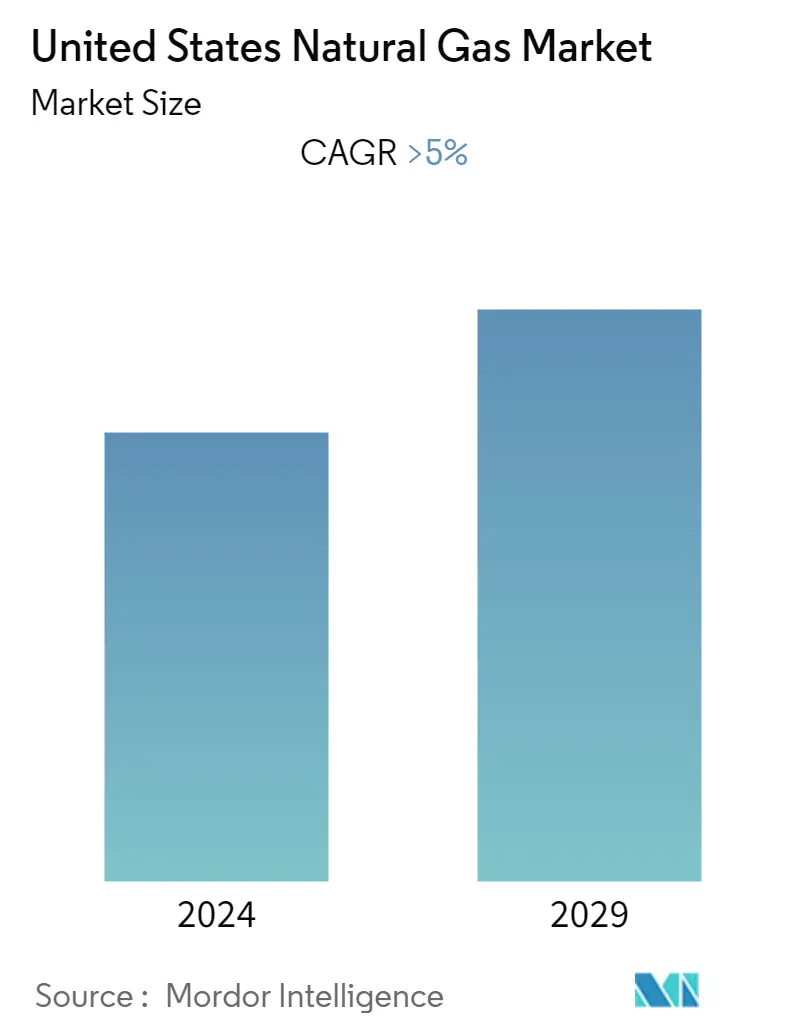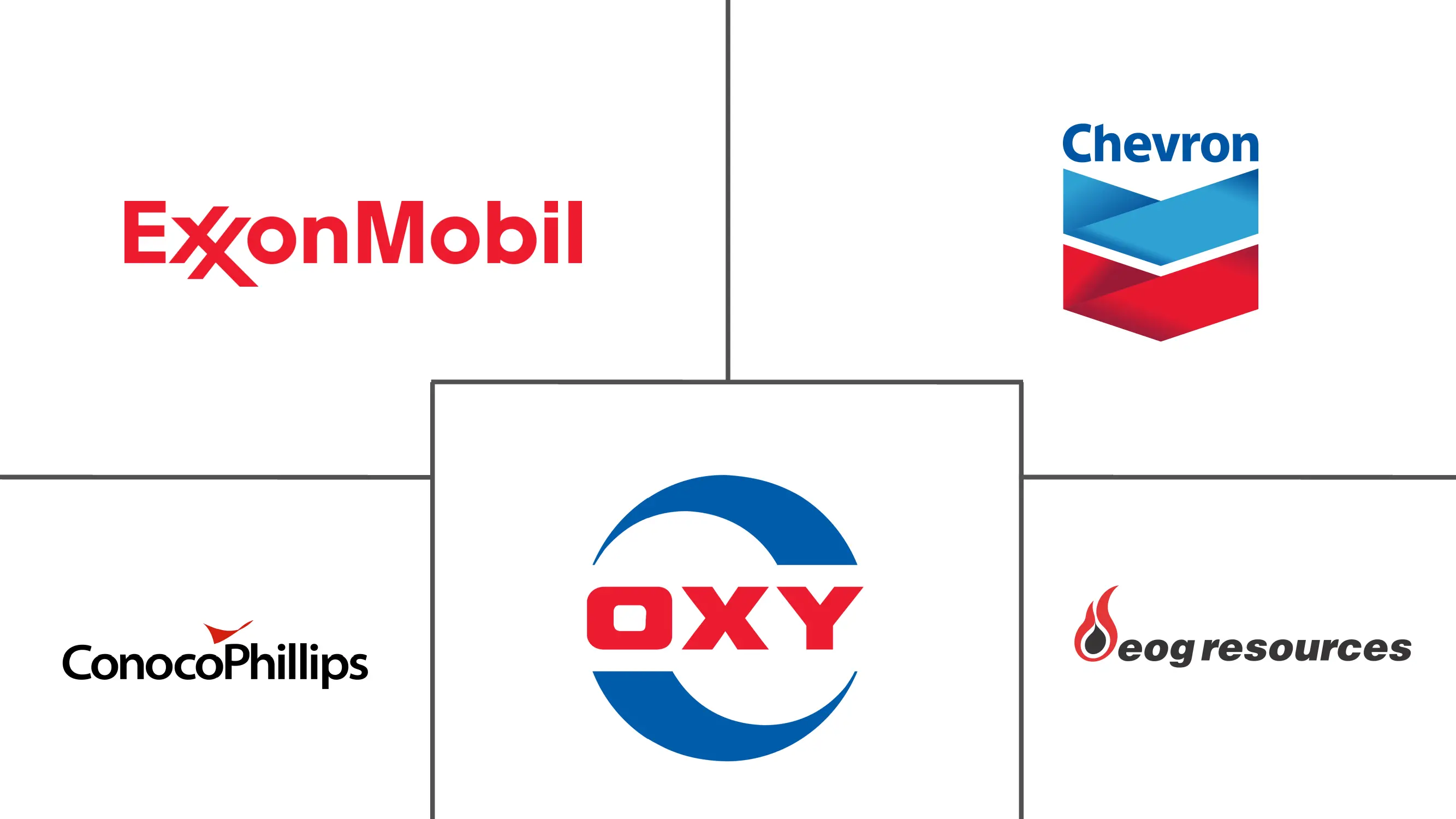Market Size of United States Natural Gas Industry

| Study Period | 2020 - 2029 |
| Base Year For Estimation | 2023 |
| Forecast Data Period | 2024 - 2029 |
| Historical Data Period | 2020 - 2022 |
| CAGR | 5.00 % |
| Market Concentration | Low |
Major Players
*Disclaimer: Major Players sorted in no particular order |
US Natural Gas Market Analysis
The US natural gas market is projected to register a CAGR of over 5% during the forecast period.
The market was negatively impacted by COVID-19 in 2020. Presently the market has reached pre-pandemic levels.
- The growing demand for cleaner energy sources and the use of natural gas to generate electricity, heat buildings, heat water, drive industrial furnaces, etc., as well as the need to reduce carbon emissions and subsidies provided by governments for using natural gas, are driving the market to grow.
- On the other hand, the risk of leaks during transportation and storage and the high cost of storing natural gas are among other factors that could limit the market's growth.
- Nevertheless, decarbonization policies have been proposed or introduced in several parts of the United States as part of the transition to a low-carbon society. By implementing renewable portfolio standards, setting net carbon-neutral clean energy standards, setting economy-wide targets for carbon reduction, and mandating the use of certain technologies, these policies rely on a range of actions. These factors can open up new opportunities for the market.
US Natural Gas Industry Segmentation
Natural gas is a naturally occurring mixture of gaseous hydrocarbons consisting primarily of methane and a variety of smaller amounts of other higher alkanes. It is common for trace gases such as carbon dioxide, nitrogen, hydrogen sulfide, and helium to be present at low levels. Since natural gas is colorless and odorless, odorizers such as mercaptan, which smells like sulfur, are commonly added to natural gas supplies in order to detect leaks. Natural gas formation occurs when layers of organic matter (mostly marine microorganisms) decompose in anaerobic conditions and are subjected to intense heat and pressure underground for millions of years under anaerobic conditions. Through photosynthesis, decayed organisms acquire energy from the sun that is then stored chemically in molecules of methane or other hydrocarbons. As well as being a fuel for vehicles, natural gas is also used for heating, cooking, and generation of electricity, as well as a chemical feedstock for the manufacture of plastics and other commercially significant organic chemicals.
The United States natural gas market is segmented by type and end use. By type, the market is segmented into wet natural gas and dry natural gas. By end use, the market is segmented into power generation, automotive, residential, and industries. The report also covers the market size and forecasts for the natural gas market across the country. For each segment, the market size and forecasts have been done based on consumption (billion cubic meters).
| Type | |
| Wet Natural Gas | |
| Dry Natural Gas |
| End Use | |
| Power Generation | |
| Automotive | |
| Residential | |
| Industries |
United States Natural Gas Market Size Summary
The US natural gas market is experiencing a robust growth trajectory, driven by the increasing demand for cleaner energy sources and the pivotal role of natural gas in electricity generation, heating, and industrial processes. The market has rebounded to pre-pandemic levels after the setbacks caused by COVID-19. Government subsidies and decarbonization policies are further propelling the market, as they encourage the transition to low-carbon energy solutions. Despite challenges such as transportation and storage risks, the market is poised for expansion, with new opportunities arising from renewable portfolio standards and carbon reduction targets. The development of gas-fired power plants, known for their efficiency and lower emissions compared to coal and oil, is a significant contributor to this growth, particularly in the power generation sector.
The United States has solidified its position as a global leader in natural gas production, with substantial consumption across various sectors, including electric power, industrial, residential, and commercial. The electric power sector, in particular, is a major consumer, with natural gas accounting for a significant portion of its energy needs. The industrial sector also relies heavily on natural gas for processes such as heating and chemical production. Additionally, the residential sector utilizes natural gas for heating and cooking, further driving demand. The market is characterized by fragmentation, with key players like ExxonMobil, Chevron, and ConocoPhillips leading the charge. Recent infrastructure developments, such as pipeline expansions and LNG facility upgrades, underscore the ongoing commitment to enhancing natural gas supply and export capabilities, ensuring the market's continued growth during the forecast period.
United States Natural Gas Market Size - Table of Contents
-
1. MARKET OVERVIEW
-
1.1 Introduction
-
1.2 Natural Gas Consumption and Forecast in billion cubic metres, till 2027
-
1.3 Recent Trends and Developments
-
1.4 Government Policies and Regulations
-
1.5 Market Dynamics
-
1.5.1 Drivers
-
1.5.2 Restraints
-
-
1.6 Supply Chain Analysis
-
1.7 PESTLE Analysis
-
-
2. MARKET SEGMENTATION
-
2.1 Type
-
2.1.1 Wet Natural Gas
-
2.1.2 Dry Natural Gas
-
-
2.2 End Use
-
2.2.1 Power Generation
-
2.2.2 Automotive
-
2.2.3 Residential
-
2.2.4 Industries
-
-
United States Natural Gas Market Size FAQs
What is the current United States Natural Gas Market size?
The United States Natural Gas Market is projected to register a CAGR of greater than 5% during the forecast period (2024-2029)
Who are the key players in United States Natural Gas Market?
ExxonMobil Corporation, Chevron Corporation, ConocoPhillips , EOG Resources, Inc. and Occidental Petroleum Corporation are the major companies operating in the United States Natural Gas Market.

